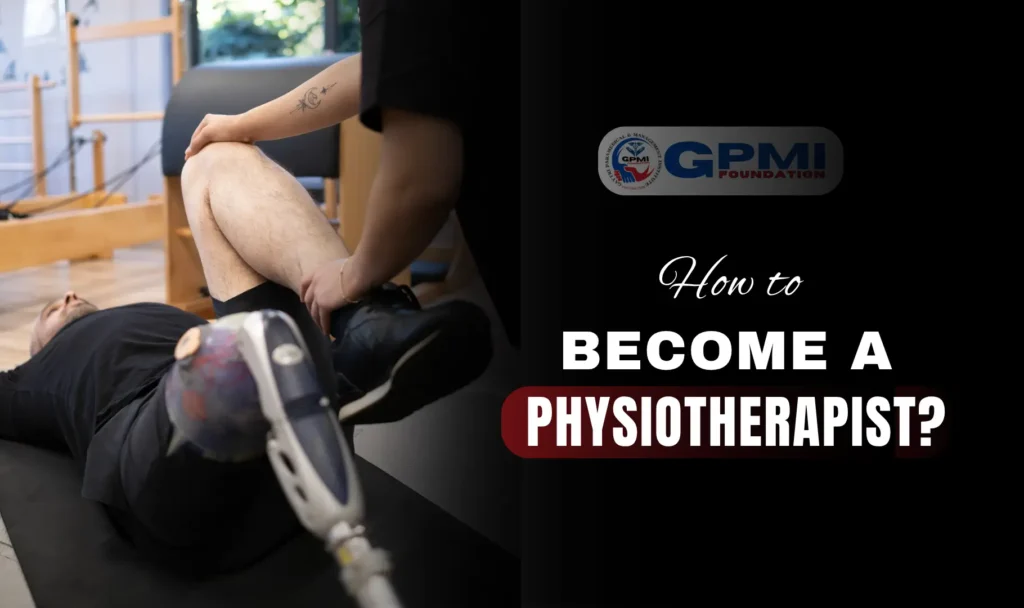Are you someone who enjoys helping others feel better? Do you want a career in the medical field that’s both rewarding and respected? If yes, then becoming a physiotherapist might be the perfect path for you! In 2025, the demand for skilled and caring physiotherapists is rising fast.
People of all ages kids, adults, and the elderly need physiotherapy to recover from injuries, improve body movements, or manage long-term pain. It’s not just about giving exercises or massages, it’s about truly understanding how the human body works and how to help it heal naturally.
This guide will walk you through the 6 simple steps to become the best physiotherapist in 2025. Whether you’re a science student just passed 12th, or someone curious about medical careers, this article is for you.
You don’t need to be a topper in the class, what you really need is the passion to care, the patience to learn, and the confidence to grow. We’ll talk about the courses you need to take, the skills you should develop, and even how to start your own clinic one day.
So, if you’re ready to step into a career that makes a real difference in people’s lives, then keep reading! Let’s get started and build your dream career together!
Table of Contents
Who is Physiotherapist?

A physiotherapist is a healthcare professional who helps people move better and live pain-free lives. They treat injuries, body pain, muscle problems, and movement issues using physical exercises, stretches, massage, and machines like ultrasound or heat therapy. Whether someone has back pain, a sports injury, or trouble walking after surgery, a physiotherapy professional knows how to help the body heal naturally.
Physiotherapist meaning is someone trained to understand how the body moves and how to fix problems without using medicine or surgery. They work with all age groups from kids with movement issues to elderly people who want to stay active. Physiotherapists also help people recover after heart attacks, strokes, or accidents.
They play a big role in hospitals, sports centers, clinics, and even at home care. Being a physiotherapist is not just a job it’s a way to help people live better every day with strength, movement, and confidence.
Different Types of Physiotherapist
Physiotherapy is a wide field with many specializations. Depending on the patient’s condition, different types of physiotherapists focus on specific areas of care and recovery. Here are the different types of physiotherapy professional based on their area of specialization:
1. Orthopedic Physiotherapist
He specializes in treating problems related to the muscles, bones, joints, ligaments, and tendons. They help patients recover from injuries like fractures, sprains, back pain, arthritis, or post-surgery stiffness. Their main goal is to reduce pain, improve strength, and restore normal movement.
Main Work & Treatment
- Treats bone and joint problems
- Helps in post-surgery rehabilitation
- Uses exercises, manual therapy, and heat/ice treatments
- Commonly works with athletes, accident patients, and arthritis sufferers
- Improves flexibility and physical function over time
Neurological Physiotherapist
He works with patients who have disorders or injuries related to the brain, spinal cord, or nerves. These can include conditions like stroke, paralysis, Parkinson’s disease, multiple sclerosis, and spinal cord injuries. Their main goal is to improve movement, balance, coordination, and overall independence in daily life.
Key points:
- Treats brain and nerve-related conditions
- Helps patients regain movement after stroke or paralysis
- Improves balance, posture, and walking ability
- Uses special exercises and techniques to retrain the nervous system
- Boosts confidence and independence in daily activities
Cardiopulmonary (Cardiorespiratory) Physiotherapist
He helps patients with heart and lung problems. They work with people suffering from conditions like asthma, chronic obstructive pulmonary disease (COPD), heart attacks, or those recovering from heart or lung surgeries.
Their main goal is to improve breathing, build stamina, and help patients return to normal daily activities. They also teach breathing exercises and techniques to clear the lungs.
Key points:
- Treats heart and lung-related conditions
- Helps in recovery after heart or lung surgeries
- Improves breathing and physical endurance
- Uses chest physiotherapy and breathing exercises
- Supports long-term respiratory care and rehabilitation
Pediatric Physiotherapist
He specializes in treating babies, children, and teenagers who have movement difficulties or developmental delays. They help children with conditions like cerebral palsy, muscular dystrophy, birth injuries, or delayed milestones such as late walking or crawling.
Their goal is to improve strength, coordination, balance, and motor skills through fun and engaging exercises specifically designed for each child’s age and ability.
Key points:
- Works with infants, children, and adolescents
- Treats conditions like cerebral palsy and muscular disorders
- Helps improve posture, balance, and motor skills
- Uses play-based therapy to make sessions child-friendly
- Encourages physical independence and confidence in daily activities
Geriatric Physiotherapist
He focuses on the health and movement needs of older adults. As people age, they may face problems like arthritis, osteoporosis, balance issues, joint pain, or weakness. Geriatric physiotherapists help elderly patients stay active, reduce pain, and maintain independence in daily life. They design gentle exercise routines to improve strength, flexibility, and balance, while also preventing falls and injuries.
Key points:
- Specializes in treating elderly patients
- Manages age-related conditions like arthritis and joint pain
- Improves balance, mobility, and posture
- Helps prevent falls and increase physical independence
- Provides personalized care for better quality of life
Sports Physiotherapist
He is an expert in treating and preventing injuries related to sports and physical activities. They work with athletes of all levels from beginners to professionals to help them recover from injuries like sprains, muscle tears, and joint problems.
Their goal is to speed up recovery, improve performance, and prevent future injuries. Sports physiotherapists also teach warm up, stretching, and strengthening exercises to keep athletes fit and injury-free.
Key points:
- Treats sports and fitness-related injuries
- Works with athletes to improve performance
- Helps in quick and safe recovery
- Uses taping, massage, and advanced physical therapy techniques
- Focuses on injury prevention and physical conditioning
Women’s Health Physiotherapist
He specializes in treating health issues related to women at different stages of life—especially during pregnancy, after childbirth, and around menopause.
They help with problems like back pain during pregnancy, pelvic floor weakness, urinary incontinence, and recovery after C-section or normal delivery. Their goal is to improve comfort, strength, and overall well-being through safe and guided physical therapy.
Key points:
- Focuses on women’s health issues
- Treats pregnancy-related pain and postnatal recovery
- Strengthens pelvic floor muscles
- Helps manage urinary and bowel problems
- Improves mobility, posture, and core strength for women
Rehabilitation Physiotherapist
He plays a key role in helping patients recover after surgeries, accidents, or serious illnesses. They work with people who have lost mobility or strength due to injuries, stroke, joint replacement, or other medical conditions.
Their main goal is to restore movement, build strength, and improve daily functioning through customized therapy plans. With the help of exercises, mobility training, and physical support, they guide patients toward a more independent life.
Key points:
- Helps in post-surgery and post-accident recovery
- Improves strength, movement, and daily function
- Designs customized rehabilitation programs
- Supports stroke and trauma patients
- Aims for long-term physical independence and recovery
Community-Based Physiotherapist
He provides care to patients in their local communities, often visiting them at home, schools, or community health centers. They help people who may not be able to visit hospitals or clinics due to age, disability, or distance.
They support recovery from injury, manage chronic illnesses, and improve mobility and quality of life within a familiar environment. Their approach is patient-friendly, accessible, and focused on long-term care.
Key points:
- Offers physiotherapy services at home or local centers
- Supports patients with mobility or travel difficulties
- Helps manage chronic conditions and disabilities
- Promotes independence and everyday functioning
- Works closely with families and community health teams
Industrial or Occupational Physiotherapist
He focuses on the health and safety of workers in factories, offices, and other workplaces. They help prevent and treat work-related injuries such as back pain, joint strain, or repetitive stress injuries caused by poor posture or heavy lifting.
They also assess the workplace setup and suggest changes to improve comfort and reduce risk. Their goal is to keep employees healthy, productive, and injury-free.
Key points:
- Specializes in workplace-related injuries
- Prevents and treats musculoskeletal problems
- Advises on proper posture and lifting techniques
- Improves employee health and productivity
- Conducts ergonomic assessments and training sessions
Physiotherapy offers a wide range of specializations, each focusing on different patient needs. From treating sports injuries and nerve disorders to helping children, elderly, and working professionals, physiotherapists play a vital role in restoring movement, reducing pain, and improving quality of life.
Physiotherapist Salary in India
The salary of physiotherapist in India varies based on experience, location, and type of work. Physiotherapy Professionals who run their own clinics or offer home visits can earn even higher depending on their client base and reputation. Salaries are usually higher in big cities like Delhi, Mumbai, Bangalore, and Chennai.
Average Salary in India:
- Freshers: ₹15,000–₹25,000/month
- 2–5 Years Experience: ₹30,000–₹50,000/month
- Private Practice/Top Hospitals: ₹70,000+/month
- Higher salaries in metro cities
- Self-employed physiotherapists can earn more
- Specialized physiotherapists (sports, neuro, ortho) earn better
The salary continues to grow with increasing demand in healthcare, fitness, and wellness sectors.
Physiotherapist Course

The course is designed to train students in treating physical injuries, movement problems, and pain through exercise, manual therapy, and other non-surgical methods. This course prepares students to become skilled professionals in hospitals, clinics, rehabilitation centers, and sports facilities.
- Physiotherapist Course Duration: The most common course is Bachelor of Physiotherapy (BPT), which is a 4.5-year program—including 4 years of academic study and 6 months of internship. After graduation, students can also pursue a Master of Physiotherapy (MPT), which takes an additional 2 years.
- Course Eligibility: To apply for the BPT course, students must have completed 10+2 with Science stream (Physics, Chemistry, and Biology). A minimum of 50% marks is usually required, though some institutes may conduct entrance exams or interviews for admission.
- Course Fees: The fees for physiotherapist courses in India vary depending on the institute. On average:
- Government colleges: ₹20,000 to ₹50,000 per year
- Private colleges: ₹70,000 to ₹2,00,000 per year
- Career Scope: After completing the course, students can work as physiotherapists in hospitals, sports teams, rehab centers, or open their own clinics. With rising awareness and demand, the career scope is excellent in India and abroad.
How to Become a Physiotherapist?

Right now, the demand for physiotherapists is growing quickly in India and around the world. It’s a smart career choice that’s both rewarding and full of opportunities. But how do you actually become a physiotherapist? Don’t worry we’ve put together a simple step-by-step guide with 6 easy steps to help you get started on this amazing journey.
Step 1: Complete 10+2 with Science (PCB)
After Class 10th, you must choose the Science stream with Biology, as this is the basic requirement for any medical or allied health course. Subjects like Physics, Chemistry, and Biology (PCB) are essential for applying to physiotherapy courses. Minimum of 50% marks in your 12th board exams. Some top colleges may have a higher cutoff, especially if they conduct entrance tests.
Step 2: Choose the Physiotherapy Course
Once you complete your 12th with PCB, choose a suitable physiotherapy course. The most popular and career-friendly option is the Bachelor of Physiotherapy (BPT). This is a 4.5-year degree course. It includes 4 years of classroom study and practical, followed by a 6-month compulsory internship in a hospital or clinic. During the course, you’ll study topics such as:
- Human Anatomy and Physiology
- Exercise Therapy
- Electrotherapy
- Pathology and Microbiology
- Biomechanics
- Rehabilitation
- Clinical Orthopedics and Neurology
Some institutes also offer Diploma in Physiotherapy (DPT), with duration 1 to 2 years. However, a diploma may offer limited job scope compared to a BPT degree. If you’re serious about making a long-term career, a degree course is highly recommended.
Step 3: Appear for Entrance Exams (if required)
Some reputed colleges and universities require you to clear an entrance exam to get admission into the BPT course. These exams may be national, state-level, or conducted by private universities. Some examples include:
- NEET-UG (in some states)
- IPU CET (Guru Gobind Singh Indraprastha University)
- LPUNEST (Lovely Professional University)
- JIPMER, Manipal Entrance Test, etc.
However, many private colleges in India offer direct admission based on merit in 12th standard, without any entrance test. You should research the admission process of the colleges you’re interested in and prepare accordingly.
Step 4: Complete Your Bachelor’s Degree (BPT)
Once admitted to a college, you will begin your Bachelor of Physiotherapy course. The course is a mix of theory, practical’s, lab work, and clinical training. Throughout the 4 years, you’ll learn how to examine patients, assess their physical conditions, and create personalized treatment plans.
In the 6-month internship, you’ll work under professional physiotherapists in real healthcare settings—such as hospitals, rehabilitation centers, and private clinics. This hands-on experience is extremely important for learning patient handling, diagnosis, and therapy techniques.
By the end of the BPT course, you’ll be ready to work in entry-level jobs or continue your education.
Step 5: Gain Experience or Pursue a Master’s Degree (MPT)
After your graduation, you can either start working as a junior physiotherapist or pursue higher studies to specialize in a particular area.
If you choose to study further, you can apply for the Master of Physiotherapy (MPT), a 2-year postgraduate program. This degree allows you to specialize in fields such as:
- Orthopedic Physiotherapy
- Neurological Physiotherapy
- Cardiorespiratory Physiotherapy
- Pediatric Physiotherapy
- Sports Physiotherapy
- Geriatric Physiotherapy
- Women’s Health Physiotherapy
Having a master’s degree increases your chances of getting better jobs, higher salaries, and leadership roles. You can also consider international certifications or short-term diplomas for advanced skills.
Step 6: Register and Start Practicing
Once you complete your BPT (and MPT if applicable), you need to register with the State Physiotherapy Council or the Indian Association of Physiotherapists (IAP). This registration is mandatory to practice legally in India as a certified physiotherapist.
After registration, you’re free to:
- Work in hospitals, private clinics, or rehabilitation centers
- Join sports teams or fitness centers
- Work as a home care physiotherapist
- Open your own physiotherapy clinic
- Apply for physiotherapy jobs abroad
Gaining experience, good communication skills, and patient handling techniques will help you grow faster in your career.
Additional Tips for Success
- Keep Learning: Attend workshops, seminars, and refresher courses. Physiotherapy is an evolving field.
- Build Soft Skills: Communication, patience, and empathy are crucial in this profession.
- Stay Fit: A healthy lifestyle and strong physical fitness will help you treat patients better.
- Use Technology: Learn about new equipment, therapy tools, and digital health platforms to enhance your practice.
By following above 6 steps, you can build a strong and successful career in physiotherapy. The scope for physiotherapists is only expected to grow, making this one of the most rewarding fields in healthcare.
Conclusion
Becoming the best physiotherapist is not just about earning a degree it’s about developing the right mindset, skills, and passion to help people live healthier and more active lives.
By following the 6 simple steps such as completing 12th with science, choosing the right physiotherapy course, gaining hands-on training, and continuing to learn, you can build a successful and meaningful career.
Specializing in areas like orthopedic, neurological, or sports physiotherapy can open up even more opportunities. Whether you want to work in a hospital, start your own clinic, or serve in your community, the possibilities are wide.
With growing awareness of physical health and wellness, the demand for skilled physiotherapists will continue to rise. So, start today, stay dedicated, and shape a future that makes a real difference.
Is Physiotherapist a Doctor?
Many people often ask whether a physiotherapist is a doctor? The answer is no—He is not a medical doctor (MBBS), but a licensed healthcare professional. They hold a degree like BPT or MPT and specialize in physical rehabilitation and therapy, not in prescribing medicines or surgeries.
Can Physiotherapist Use Dr?
Physiotherapists can use the title “Dr” before their name, but only with a clear mention of their qualification, such as “Dr. Rahul Sharma (PT).” This indicates that they are a physiotherapist, not a medical doctor, and helps avoid confusion.
What Does a Physiotherapist Do?
A physiotherapist helps people recover from injuries, manage pain, and improve movement through exercises, stretches, and hands-on therapy. They treat conditions related to bones, muscles, nerves, and joints, helping patients regain strength, mobility, and confidence in their daily activities.
Can I Do Physiotherapy Without NEET?
Yes, you can do physiotherapy without NEET. Most colleges in India offer admission to Bachelor of Physiotherapy (BPT) based on your 12th marks in the science stream (PCB). Some institutes may have their own entrance exams, but NEET is usually not required.







